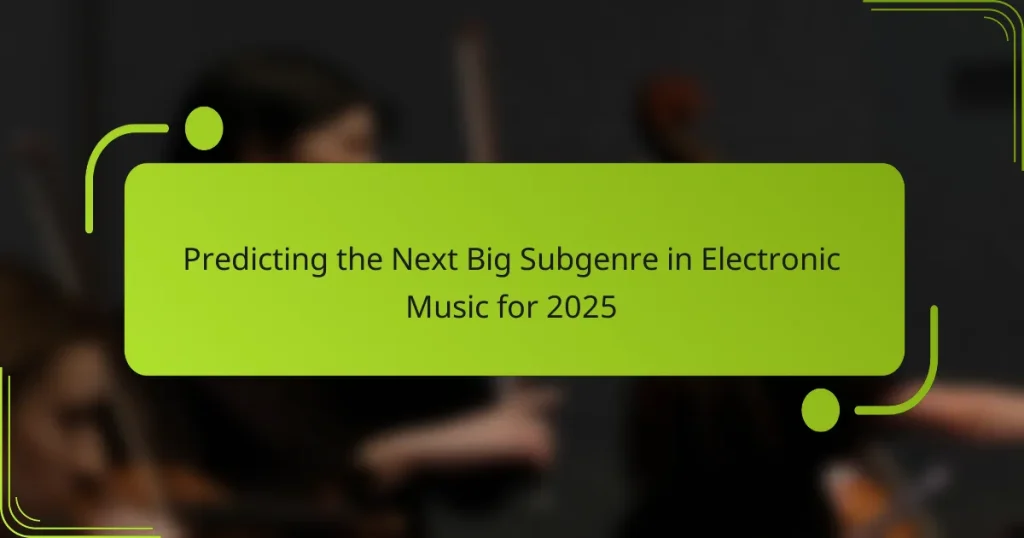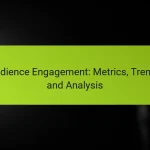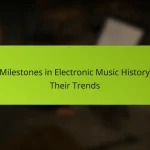As we look ahead to 2025, the landscape of electronic music is set to evolve with the rise of innovative subgenres like Ambient Trap, Hyperpop, and Techno Fusion. These styles not only reflect changing listener preferences but also leverage advancements in technology to create fresh auditory experiences. Artists who adapt to these trends and utilize modern production tools will be well-positioned to resonate with audiences in this dynamic musical environment.

What are the emerging electronic music subgenres for 2025?
In 2025, several electronic music subgenres are gaining traction, reflecting evolving tastes and technological advancements. Key emerging styles include Ambient Trap, Hyperpop, Techno Fusion, Future Garage, and Glitch Hop, each offering unique sounds and experiences.
Ambient Trap
Ambient Trap combines atmospheric soundscapes with the rhythmic elements of trap music. This subgenre often features lush synths, reverb-laden vocals, and slow, heavy beats, creating an immersive listening experience.
Artists exploring Ambient Trap typically focus on mood and texture, making it suitable for both relaxation and introspection. Tracks may range from 70 to 90 BPM, allowing for a laid-back vibe while still maintaining the energy of trap.
Hyperpop
Hyperpop is characterized by its exaggerated pop aesthetics, blending elements from various genres like electronic, hip-hop, and punk. This subgenre often features high-pitched vocals, glitchy production, and vibrant melodies, appealing to a youthful audience.
With tracks often exceeding 200 BPM, Hyperpop is energetic and playful. Artists like 100 gecs and Charli XCX are leading the way, pushing boundaries and embracing a DIY ethos that resonates with fans.
Techno Fusion
Techno Fusion merges traditional techno beats with influences from other genres, such as house, trance, and even world music. This subgenre emphasizes innovation and experimentation, often resulting in diverse sound palettes.
Producers in this space may incorporate live instruments or unique samples, creating a rich auditory experience. Expect tracks to vary in tempo, typically ranging from 120 to 140 BPM, appealing to both club-goers and casual listeners.
Future Garage
Future Garage is a modern take on the classic garage sound, incorporating elements of UK bass music and ambient influences. This subgenre often features shuffled beats, deep basslines, and ethereal vocal samples, creating a moody atmosphere.
Tracks typically hover between 130 and 140 BPM, making them suitable for both dance floors and relaxed settings. Artists often use intricate sound design to evoke emotion, making Future Garage a compelling choice for listeners seeking depth.
Glitch Hop
Glitch Hop combines hip-hop rhythms with glitchy, electronic sounds, creating a unique fusion that is both rhythmic and experimental. This subgenre often features chopped-up samples, heavy bass, and syncopated beats.
Tracks usually range from 80 to 110 BPM, allowing for a laid-back yet engaging listening experience. Artists like Opiuo and The Glitch Mob exemplify this style, showcasing creativity through intricate production techniques.

How can artists capitalize on these trends?
Artists can capitalize on emerging electronic music trends by staying informed, collaborating with innovators, and leveraging digital platforms for exposure. By actively engaging with the evolving landscape, they can create relevant and appealing music that resonates with audiences.
Collaborate with genre pioneers
Working with established artists in new subgenres can provide valuable insights and credibility. Collaborations can lead to unique soundscapes that blend different influences, attracting a wider audience. Seek out pioneers who are pushing boundaries and explore joint projects that showcase both artists’ strengths.
Consider reaching out to artists who have successfully navigated similar trends. This could involve co-producing tracks, remixing each other’s work, or even performing together at events. Such partnerships can enhance visibility and create buzz around your music.
Utilize social media for promotion
Social media platforms are essential for promoting new music and connecting with fans. Utilize platforms like Instagram, TikTok, and Twitter to share behind-the-scenes content, teasers, and live performances. Engaging with followers through polls and Q&A sessions can also foster a sense of community.
Regularly update your profiles with fresh content and collaborate with influencers to expand your reach. Consider using targeted ads to promote new releases, especially during key moments like album drops or festival appearances. This approach can significantly increase your audience engagement and visibility.
Experiment with hybrid sounds
Hybrid sounds combine elements from different genres, creating fresh and innovative music. Artists should explore blending styles like techno with world music or house with classical elements. This experimentation can lead to unique tracks that stand out in a crowded market.
Start by identifying genres that resonate with your current style and audience. Create a list of potential influences and experiment with incorporating them into your music. Be open to feedback and iterate on your sound to refine it further. This approach can help you stay ahead of trends and attract diverse listeners.
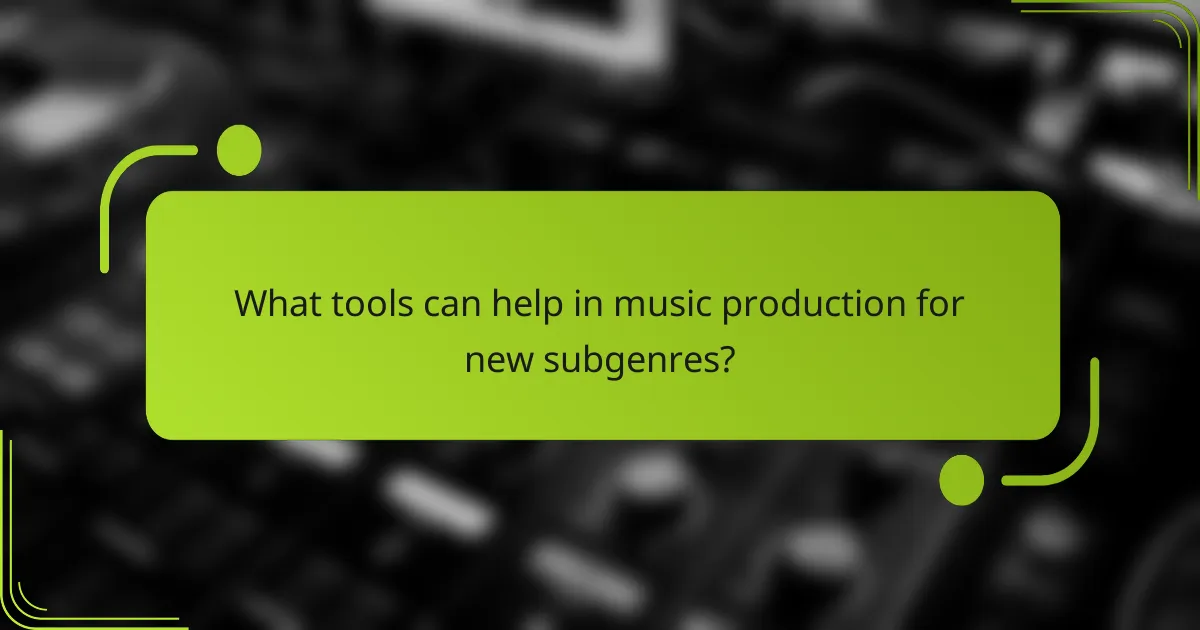
What tools can help in music production for new subgenres?
Several digital audio workstations (DAWs) and production tools can significantly enhance music production for emerging electronic subgenres. These tools offer unique features that cater to different styles, making them essential for producers looking to innovate.
Ableton Live
Ableton Live is a versatile DAW favored by many electronic music producers for its intuitive interface and powerful live performance capabilities. It allows users to create, edit, and arrange music in a non-linear fashion, which is particularly useful for experimenting with new subgenres.
Key features include Session View for improvisation and a wide range of built-in instruments and effects. Producers should consider utilizing its Max for Live integration to expand their sound palette with custom devices and plugins.
FL Studio
FL Studio is known for its user-friendly layout and strong emphasis on beat-making, making it a popular choice for electronic music genres. Its pattern-based workflow allows for quick composition and arrangement, which is ideal for producers exploring new sounds.
With a rich library of samples and plugins, FL Studio supports a variety of production styles. Users should take advantage of its automation features to create dynamic tracks that stand out in the evolving electronic landscape.
Serato Studio
Serato Studio is designed for beat makers and DJs, offering a straightforward interface that simplifies music production. It integrates seamlessly with Serato DJ software, making it a great choice for those looking to produce tracks for live performance.
Producers can utilize its sample-based workflow and built-in drum kits to quickly generate ideas. It’s advisable to explore its key detection and tempo features to ensure tracks are compatible with various subgenres and performance settings.
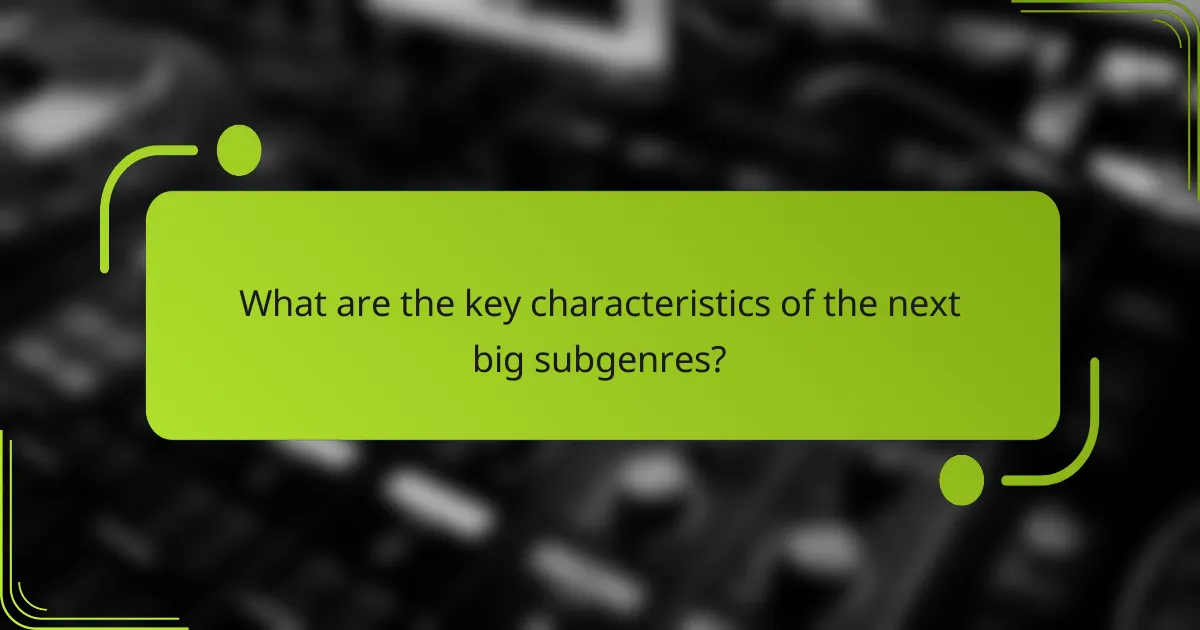
What are the key characteristics of the next big subgenres?
The next big subgenres in electronic music will likely feature innovative sound design, cross-genre influences, and a strong emphasis on digital collaboration. These characteristics will shape the sound and production techniques that define emerging styles in the coming years.
Innovative sound design
Innovative sound design involves the use of unique audio techniques and technologies to create fresh sonic textures. Producers are increasingly experimenting with granular synthesis, field recordings, and algorithmic composition to push the boundaries of traditional electronic music.
For example, artists might blend organic sounds with synthesized elements to create a hybrid auditory experience. This approach not only captivates listeners but also sets the stage for new subgenres that prioritize originality and experimentation.
Cross-genre influences
Cross-genre influences refer to the blending of styles from different musical genres to create something entirely new. In electronic music, this can mean incorporating elements from hip-hop, jazz, or world music, resulting in a rich tapestry of sounds that appeal to diverse audiences.
Producers should consider how to integrate various rhythmic patterns, instrumentation, and vocal styles from other genres. This fusion can lead to innovative tracks that resonate with fans across multiple musical landscapes, increasing their reach and impact.
Emphasis on digital collaboration
The emphasis on digital collaboration highlights the growing trend of artists working together remotely using online platforms. This allows musicians from different parts of the world to contribute to projects, sharing ideas and techniques that enhance the creative process.
Tools like cloud-based DAWs and collaborative software enable seamless communication and file sharing. Artists should leverage these technologies to expand their networks and explore new creative possibilities, ultimately leading to more dynamic and diverse electronic music subgenres.
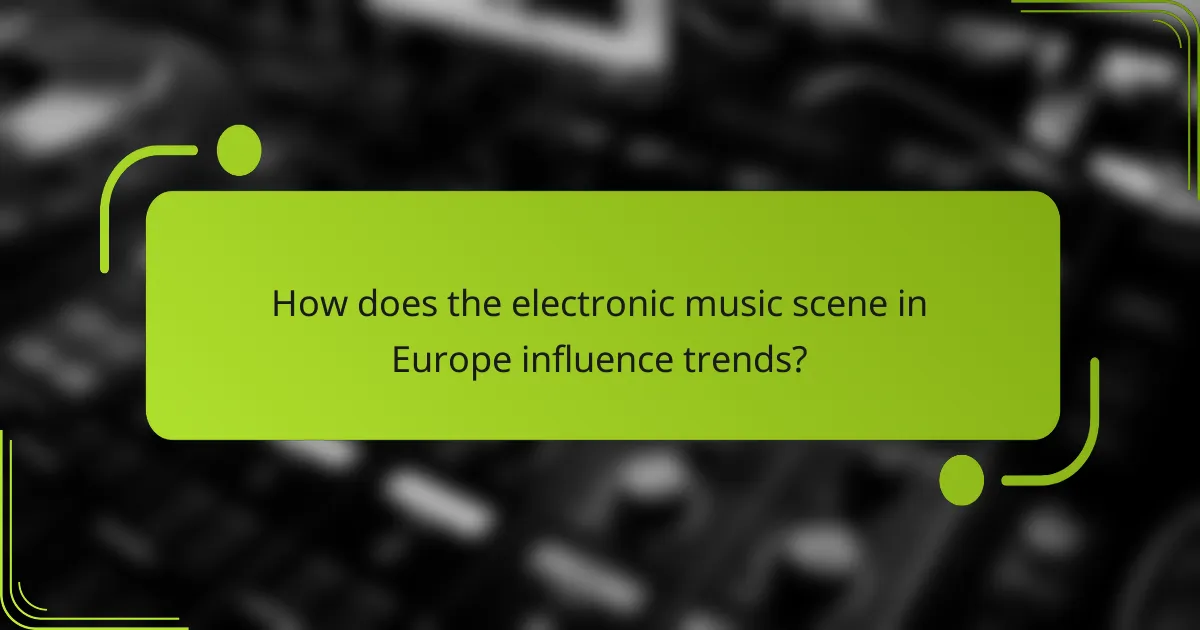
How does the electronic music scene in Europe influence trends?
The electronic music scene in Europe plays a crucial role in shaping global trends by fostering innovation and experimentation. Cities like Berlin, London, and Paris serve as cultural hubs where new subgenres emerge, driven by local artists and vibrant communities.
Berlin’s underground culture
Berlin’s underground culture is renowned for its avant-garde approach to electronic music, often pushing boundaries and redefining genres. Venues like Berghain and Sisyphos are incubators for new sounds, where DJs and producers experiment with techno, house, and other styles.
This city’s emphasis on inclusivity and artistic freedom encourages a diverse range of musical expressions, often leading to the birth of new subgenres. The collaborative spirit among artists and the influence of local collectives further amplify Berlin’s impact on the global electronic music landscape.
London’s diverse music scene
London boasts a rich tapestry of musical influences, blending genres like dubstep, garage, and grime with electronic elements. This diversity allows for constant evolution, as artists draw inspiration from various cultural backgrounds and musical traditions.
Key venues such as Fabric and Printworks host a variety of events that showcase both established and emerging talent. The city’s dynamic nightlife and festival culture contribute to the rapid dissemination of new sounds, making London a significant player in the evolution of electronic music.
Parisian electronic festivals
Paris is home to several prominent electronic music festivals, such as Weather and Pitchfork Music Festival, which highlight both local and international talent. These events serve as platforms for artists to debut new material and experiment with different styles, influencing trends across Europe and beyond.
The city’s unique blend of art, fashion, and music creates an environment ripe for innovation. As Paris continues to host diverse electronic music events, it solidifies its position as a key influencer in the global electronic music scene.
